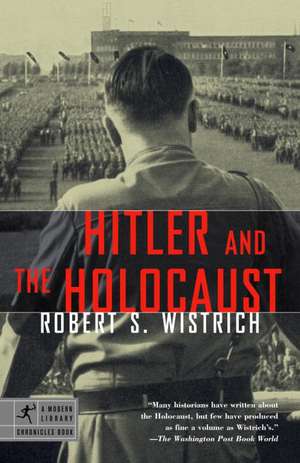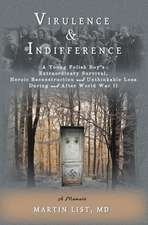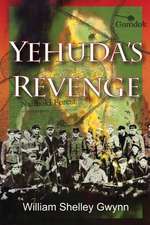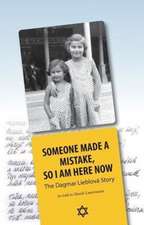Hitler and the Holocaust: Modern Library Chronicles
Autor Robert S. Wistrichen Limba Engleză Paperback – 31 iul 2003
Din seria Modern Library Chronicles
-
 Preț: 125.06 lei
Preț: 125.06 lei -
 Preț: 94.47 lei
Preț: 94.47 lei -
 Preț: 88.68 lei
Preț: 88.68 lei -
 Preț: 88.86 lei
Preț: 88.86 lei -
 Preț: 119.77 lei
Preț: 119.77 lei -
 Preț: 94.66 lei
Preț: 94.66 lei -
 Preț: 120.59 lei
Preț: 120.59 lei -
 Preț: 112.52 lei
Preț: 112.52 lei -
 Preț: 113.97 lei
Preț: 113.97 lei -
 Preț: 98.34 lei
Preț: 98.34 lei -
 Preț: 103.09 lei
Preț: 103.09 lei -
 Preț: 144.04 lei
Preț: 144.04 lei -
 Preț: 110.47 lei
Preț: 110.47 lei -
 Preț: 105.19 lei
Preț: 105.19 lei -
 Preț: 115.75 lei
Preț: 115.75 lei -
 Preț: 117.35 lei
Preț: 117.35 lei -
 Preț: 96.67 lei
Preț: 96.67 lei -
 Preț: 109.24 lei
Preț: 109.24 lei -
 Preț: 101.71 lei
Preț: 101.71 lei -
 Preț: 96.46 lei
Preț: 96.46 lei
Preț: 122.45 lei
Nou
Puncte Express: 184
Preț estimativ în valută:
23.43€ • 24.37$ • 19.35£
23.43€ • 24.37$ • 19.35£
Carte disponibilă
Livrare economică 22 martie-05 aprilie
Preluare comenzi: 021 569.72.76
Specificații
ISBN-13: 9780812968637
ISBN-10: 0812968638
Pagini: 320
Dimensiuni: 132 x 204 x 17 mm
Greutate: 0.25 kg
Ediția:Reprint
Editura: Modern Library
Seria Modern Library Chronicles
ISBN-10: 0812968638
Pagini: 320
Dimensiuni: 132 x 204 x 17 mm
Greutate: 0.25 kg
Ediția:Reprint
Editura: Modern Library
Seria Modern Library Chronicles
Notă biografică
Robert S. Wistrich is professor of modern European history at the Hebrew University of Jerusalem and head of its International Center for the Study of Antisemitism. He is the author and editor of twenty-two books, several of which have won international awards, including Antisemitism: The Longest Hatred.
Extras
Anti-Semitism and the Jews
"After Satan Christians have no greater enemies than the Jews. . . . They pray many times each day that God may destroy us through pestilence, famine and war, aye, that all beings and creatures may rise up with them against the Christians."
-Abraham a Sancta Clara Viennese Catholic preacher (1683)
"I hold the Jewish race to be the born enemy of pure humanity and everything noble in it. It is certain that it is running us Germans into the ground, and I am perhaps the last German who knows how to hold himself upright in the face of Judaism, which already rules everything."
-Richard Wagner (1881)
"Jewry is one of the great negative principles of world history and thus can only be understood as a parasite within the opposing positive principle. As little as Judas Iscariot with his thirty silver coins . . . can be understood without the Lord whose community he sneeringly betrayed . . . that night side of history called Jewry cannot be understood without being positioned in the totality of the historical process where God and Satan, Creation and Destruction confront each other in an eternal struggle."
-Walter Frank, “German Science in Its Struggle against World Jewry,” German radio broadcast, 11 and 13 January 1939
Throughout recorded time, there have been countless massacres, some on religious grounds, others for political or territorial reasons. Native peoples have been exterminated in colonial wars. Millions of Africans were sold into slavery. The colonization of North America, Australia, Africa, and other parts of the globe by expanding Western societies involved constant displacement, despoliation, and sometimes even the genocide of indigenous populations in the name of empire, plunder, and “progress.” The Turkish massacre of more than a million Armenians during the First World War marked a new scale of brutality. However, if the number of victims alone were to be our point of departure, then we should look to those unfortunate Soviet citizens who were shot, starved, or worked to death in the gulags of Stalinist Russia as “enemies of the people,” in the name of Marxist ideology. The victims of this “autogenocide,” which a totalitarian regime inflicted on its own subjects, may have numbered as many as twenty million. (While staggeringly high, this was a much lower percentage of all Soviet citizens than the one third of all Jewish people in the world who were killed by the Nazis.) No less horrifying were the events in Maoist China (the full story has yet to be told) and, on a smaller scale, in Communist Cambodia during the 1970s. The slaughter in Rwanda and “ethnic cleansing” in the former Yugoslavia in the 1990s demonstrate that the genocidal chapter in human history is far from over.
Even during the Second World War, several genocides occurred, though of different magnitudes. Approximately three million Polish Gentiles fell victim to the Nazis, as did a similar number of Russian POWs who were starved to death by the Germans. Both groups were used as guinea pigs at Auschwitz-Birkenau before the gassing of Jews began. The German war in the east involved much more than exterminating the Jews: it was initially conceived of as part of a larger design for a radical racial restructuring in which Poles, Russians, and Ukrainians would be expropriated, deported, or killed. Gypsies, too, were earmarked for destruction; between 250,000 and half a million Gypsies were sent to their deaths between 1939 and 1945, coterminous with the Jewish Holocaust. Gypsies (Roma and Sinti) did not, of course, hold the same place either in Christian consciousness or in the Nazi worldview as did Jews or Judaism, but prejudice and hostility toward their nomadic way of life was nonetheless widespread and in some ways comparable to the perception of Jews as alien to Christian Europe.
The Nazis were particularly hostile toward the Gypsies as an “antisocial” element and as “people of different blood” who fell under the Nuremberg race laws of 1935. (Heinrich Himmler’s decree of December 1937 permitted their arrest on the extremely elastic grounds of asocial behavior, even without the commission of any criminal act.) As early as 1936, some groups of Gypsies were sent to the Dachau concentration camp. Further legislation in 1938 to deal with the “Gypsy plague” aimed at a strict separation between “pure” (Sinti and Lalleri) and “mixed blood” Gypsies, as well as between Germans and Gypsies. According to the Nazi Office for Racial Hygiene and Population Biology, more than 90 percent of the German Gypsies were defined as non-Aryan “mixed bloods,” the favored government policy toward which was sterilization. During the war, Nazi policy became even more radical, and in the fall of 1941, five thousand Austrian Gypsies were deported to the Lódz ghetto. Then, in early 1942, some Gypsies were murdered along with Jews in the Chelmno death camp. Gypsies started arriving in Auschwitz-Birkenau on 26 February 1943; a great many died from hunger, disease, and “medical experiments.” In 1944, women and children were gassed. In the Baltic states and the Soviet Union, Gypsies were murdered by the Einsatzgruppen; in Yugoslavia, they were killed by the Paveli´c regime; in Hungary, they were persecuted and rounded up by Arrow Cross fascists. In France, they were interned and later sent to camps in Germany. Two thirds of the Polish Gypsies died under Nazi occupation.
The Nazis regarded “the fight against the Gypsy Menace” after 1935 as “a matter of race” and insisted on the need to “separate once and for all the Gypsy race (Zigeunertum) from the German nation (Volkstum),” to prevent the danger of miscegenation. In that respect, there was an ideological link between the murder of Jews and Gypsies in the Nazi vision of radical ethnic cleansing or “purification” of the Volksge- meinschaft (people’s community). Indeed, the settlement of the “Gypsy question” was conceived from the outset in the framework of “knowledge stemming from ethnological research” under the jurisdiction of Heinrich Himmler as Reichsführer SS and chief of the German police. The fate of the Gypsies, as Himmler made clear in September 1942, was not a matter for the law or the courts, any more than was that of the Jews. Hence, they were totally at the mercy of the police and the SS and were liable to be thrown at any time into concentration camps. The accusations against them of hereditary racial inferiority, economic parasitism, or sexual “immorality,” all of which were seen as threatening to the general German population, overlapped with the demagoguery of anti-Semitism. The Gypsies, however, were deemed a “social menace,” not a total and universal enemy like the Jews, engaged in a universal conspiracy against Germany and the “Aryan” world. The “Gypsy question” had, for example, only marginal importance in the Nazi political agenda, and Hitler himself referred publicly to Gypsies on only two occasions, in stark contrast to his relentless obsession with the Jews. Moreover, those Gypsies who were considered “racially pure” were never regarded as a danger to the German people and were even thought of as having noble blood. Thus, the horrible crime against the Gypsies as a social group did not aim in principle at their total annihilation.
The Jewish Holocaust was unprecedented—as compared to other genocides—because it was the planned, deliberate policy decision of a powerful state that mobilized its resources to destroy the entire Jewish people. In this diabolical aim, the Germans were almost successful in Europe, and only their military defeat prevented its gruesome completion. By 1945, two thirds of European Jewry had been wiped out by the Nazis, leaving only a remnant of the ancient Jewish culture that had existed on European soil for nearly two millennia. One of the more remarkable aspects of this mass murder was that Jews never constituted (except in the paranoid Nazi mind-set) any economic, political, or military threat to the German state. On the contrary, had there been a Nobel Prize for passionate identification with German language and culture before 1933, the Jews would surely have won it. During the First World War, many made great efforts to demonstrate their patriotic loyalty and validate their Germannness (Deutschtum) on the battlefield. Before the rise of Hitler, they had felt very much at home in what they regarded as a well-ordered state, based on the rule of law.
If anything, there were striking affinities between Germans and Jews that seemed to augur well for their common future: a great respect for education, hard work, the importance of the family, and a marked talent for abstract, speculative thinking. Both Germans and Jews were considered highly musical and often regarded by others as being both indispensable and troublesome, aggressive and prone to self-pity. Judenhass (Judeophobia) and Deutschenhass (Germanophobia) had more than a few attributes in common. But, as Freud shrewdly observed, the “narcissism of little differences” can produce great hatreds; proximity, affinity, and assimilation may in certain circumstances give rise to an intense and irrational backlash. The German “Jewish question” of the nineteenth and twentieth centuries was precisely such a case, amalgamating false perceptions, stereotypes, and delusions from many sources: Christian anti-Judaism, neo-Romantic völkisch mysticism, and a racist obsession with Jews and other “aliens” that assumed a special virulence in Nazi ideology.8
This shadowboxing with imaginary demons and projective angst persuaded the novelist Jakob Wassermann that Judeophobia was the German national hatred—a self-induced pathological delusion that was not only irrational but impenetrable. Germans, he concluded in 1921, were emotionally resistant to accepting Jews as their equals and given to scapegoating them for every crisis, setback, or defeat. Hatred of the Jews could encompass every conceivable sexual frus- tration, social anxiety, jealousy, animosity, bloodlust, and greedy instinct that Germans were otherwise unable to exor- cise.9 Thirty years earlier, the German philosopher Friedrich Nietzsche had been equally severe, heaping aristocratic contempt on the anti-Semites of the 1880s as Schlechtweggekommene— life’s losers and born misfits; bungled, botched, and envious creatures, eaten up with neurotic ressentiment.10 This verdict was all the more remarkable since Nietzsche had at one time been under the spell of the composer Richard Wagner—the fons et origo of modern German anti-Semitism. Moreover, to compound the irony, his own rhetoric about the Übermensch (superman), the “blond beast,” and the “will to power” would later be eagerly annexed by fascists and Nazis. Indeed, Nietzsche’s relentless assault on Judeo-Christian morality did provide one of the deeper sources of inspiration for the Nazi revolution. It was, after all, Nietzsche who had branded priestly Judaism and the teachings of the Gospels as the beginning of “the slave-revolt in morals.” The Jews, he explained with oracular certitude, had engineered the greatest transvaluation of values in world history, two thousand years earlier in Roman-occupied Palestine. It was a most fateful and catastrophic event, responsible in his eyes for all the “decadent” modern ideologies of liberalism, rationalism, socialism, and leveling mass democracy.11 In the 1930s, it would not be difficult for fascists and Nazis—intoxicated with self- deification—to adapt these Nietzschean ideas to their own totalitarian-nihilist agenda.12
It mattered little that few Nazis had actually read Nietzsche or paid attention to his contempt for Germans and admiration for Jews. The attraction lay in the prospect of transgression on a grand scale, the Nietzschean smashing of those taboos that still reined in the barbarian warrior-lust lurking under an increasingly thin “civilized” veneer. Nazism, (mis)understood as a Nietzschean experiment, seemed to be offering to the German people a Faustian pact. In return for destroying traditional Christian moral restraints, they might be granted future hegemony over the earthly kingdoms that other European powers had already partitioned among themselves.
The demonization of the Jews and Judaism assumed immense symbolic importance in this endeavor. The Nazi leaders (and especially Hitler) were obsessed with the idea of a “chosen people” and its imagined secret power. They read into it a prefiguration of their own will to set the races apart under an iron law until the end of time.13 The singularity of the Jews, and the mystery of their survival over thousands of years, was treated as if it were a vindication of the eternal truths of blood and race.14 Nazi racism can indeed be seen as a blasphemous gloss or perhaps even as a grotesque parody of Judaic chosenness. To put it bluntly, there could not be two chosen peoples. The character of Hitler’s messianic pretensions necessitated the removal of that very people who had embodied chosenness for three millennia. The Jews were responsible (or, rather, guilty) in his eyes for having invented the very notion of a moral conscience, in defiance of all healthy, natural instincts.15 They had bequeathed this noxious ideal to Christianity and Communism, with their contending dreams of the brotherhood of man, human equality, and justice. Though outwardly incompatible, these worldviews were for the Nazis two sides of the same Judaic coin: egalitarian ideals that had caused endless suffering, persecution, and intolerance. Moreover, the Jews were accused of having deliberately encouraged the mixing of races, as well as inventing doctrines of democracy, which could only destroy the foundations of human culture itself. For the Nazis, the world had to be liberated from such “evil” principles so that mankind could return once more to its pristine natural order. Thus the planned, systematic eradication of Judaic values was the necessary prerequisite of the physical annihilation of the Jewish people.
From the Hardcover edition.
"After Satan Christians have no greater enemies than the Jews. . . . They pray many times each day that God may destroy us through pestilence, famine and war, aye, that all beings and creatures may rise up with them against the Christians."
-Abraham a Sancta Clara Viennese Catholic preacher (1683)
"I hold the Jewish race to be the born enemy of pure humanity and everything noble in it. It is certain that it is running us Germans into the ground, and I am perhaps the last German who knows how to hold himself upright in the face of Judaism, which already rules everything."
-Richard Wagner (1881)
"Jewry is one of the great negative principles of world history and thus can only be understood as a parasite within the opposing positive principle. As little as Judas Iscariot with his thirty silver coins . . . can be understood without the Lord whose community he sneeringly betrayed . . . that night side of history called Jewry cannot be understood without being positioned in the totality of the historical process where God and Satan, Creation and Destruction confront each other in an eternal struggle."
-Walter Frank, “German Science in Its Struggle against World Jewry,” German radio broadcast, 11 and 13 January 1939
Throughout recorded time, there have been countless massacres, some on religious grounds, others for political or territorial reasons. Native peoples have been exterminated in colonial wars. Millions of Africans were sold into slavery. The colonization of North America, Australia, Africa, and other parts of the globe by expanding Western societies involved constant displacement, despoliation, and sometimes even the genocide of indigenous populations in the name of empire, plunder, and “progress.” The Turkish massacre of more than a million Armenians during the First World War marked a new scale of brutality. However, if the number of victims alone were to be our point of departure, then we should look to those unfortunate Soviet citizens who were shot, starved, or worked to death in the gulags of Stalinist Russia as “enemies of the people,” in the name of Marxist ideology. The victims of this “autogenocide,” which a totalitarian regime inflicted on its own subjects, may have numbered as many as twenty million. (While staggeringly high, this was a much lower percentage of all Soviet citizens than the one third of all Jewish people in the world who were killed by the Nazis.) No less horrifying were the events in Maoist China (the full story has yet to be told) and, on a smaller scale, in Communist Cambodia during the 1970s. The slaughter in Rwanda and “ethnic cleansing” in the former Yugoslavia in the 1990s demonstrate that the genocidal chapter in human history is far from over.
Even during the Second World War, several genocides occurred, though of different magnitudes. Approximately three million Polish Gentiles fell victim to the Nazis, as did a similar number of Russian POWs who were starved to death by the Germans. Both groups were used as guinea pigs at Auschwitz-Birkenau before the gassing of Jews began. The German war in the east involved much more than exterminating the Jews: it was initially conceived of as part of a larger design for a radical racial restructuring in which Poles, Russians, and Ukrainians would be expropriated, deported, or killed. Gypsies, too, were earmarked for destruction; between 250,000 and half a million Gypsies were sent to their deaths between 1939 and 1945, coterminous with the Jewish Holocaust. Gypsies (Roma and Sinti) did not, of course, hold the same place either in Christian consciousness or in the Nazi worldview as did Jews or Judaism, but prejudice and hostility toward their nomadic way of life was nonetheless widespread and in some ways comparable to the perception of Jews as alien to Christian Europe.
The Nazis were particularly hostile toward the Gypsies as an “antisocial” element and as “people of different blood” who fell under the Nuremberg race laws of 1935. (Heinrich Himmler’s decree of December 1937 permitted their arrest on the extremely elastic grounds of asocial behavior, even without the commission of any criminal act.) As early as 1936, some groups of Gypsies were sent to the Dachau concentration camp. Further legislation in 1938 to deal with the “Gypsy plague” aimed at a strict separation between “pure” (Sinti and Lalleri) and “mixed blood” Gypsies, as well as between Germans and Gypsies. According to the Nazi Office for Racial Hygiene and Population Biology, more than 90 percent of the German Gypsies were defined as non-Aryan “mixed bloods,” the favored government policy toward which was sterilization. During the war, Nazi policy became even more radical, and in the fall of 1941, five thousand Austrian Gypsies were deported to the Lódz ghetto. Then, in early 1942, some Gypsies were murdered along with Jews in the Chelmno death camp. Gypsies started arriving in Auschwitz-Birkenau on 26 February 1943; a great many died from hunger, disease, and “medical experiments.” In 1944, women and children were gassed. In the Baltic states and the Soviet Union, Gypsies were murdered by the Einsatzgruppen; in Yugoslavia, they were killed by the Paveli´c regime; in Hungary, they were persecuted and rounded up by Arrow Cross fascists. In France, they were interned and later sent to camps in Germany. Two thirds of the Polish Gypsies died under Nazi occupation.
The Nazis regarded “the fight against the Gypsy Menace” after 1935 as “a matter of race” and insisted on the need to “separate once and for all the Gypsy race (Zigeunertum) from the German nation (Volkstum),” to prevent the danger of miscegenation. In that respect, there was an ideological link between the murder of Jews and Gypsies in the Nazi vision of radical ethnic cleansing or “purification” of the Volksge- meinschaft (people’s community). Indeed, the settlement of the “Gypsy question” was conceived from the outset in the framework of “knowledge stemming from ethnological research” under the jurisdiction of Heinrich Himmler as Reichsführer SS and chief of the German police. The fate of the Gypsies, as Himmler made clear in September 1942, was not a matter for the law or the courts, any more than was that of the Jews. Hence, they were totally at the mercy of the police and the SS and were liable to be thrown at any time into concentration camps. The accusations against them of hereditary racial inferiority, economic parasitism, or sexual “immorality,” all of which were seen as threatening to the general German population, overlapped with the demagoguery of anti-Semitism. The Gypsies, however, were deemed a “social menace,” not a total and universal enemy like the Jews, engaged in a universal conspiracy against Germany and the “Aryan” world. The “Gypsy question” had, for example, only marginal importance in the Nazi political agenda, and Hitler himself referred publicly to Gypsies on only two occasions, in stark contrast to his relentless obsession with the Jews. Moreover, those Gypsies who were considered “racially pure” were never regarded as a danger to the German people and were even thought of as having noble blood. Thus, the horrible crime against the Gypsies as a social group did not aim in principle at their total annihilation.
The Jewish Holocaust was unprecedented—as compared to other genocides—because it was the planned, deliberate policy decision of a powerful state that mobilized its resources to destroy the entire Jewish people. In this diabolical aim, the Germans were almost successful in Europe, and only their military defeat prevented its gruesome completion. By 1945, two thirds of European Jewry had been wiped out by the Nazis, leaving only a remnant of the ancient Jewish culture that had existed on European soil for nearly two millennia. One of the more remarkable aspects of this mass murder was that Jews never constituted (except in the paranoid Nazi mind-set) any economic, political, or military threat to the German state. On the contrary, had there been a Nobel Prize for passionate identification with German language and culture before 1933, the Jews would surely have won it. During the First World War, many made great efforts to demonstrate their patriotic loyalty and validate their Germannness (Deutschtum) on the battlefield. Before the rise of Hitler, they had felt very much at home in what they regarded as a well-ordered state, based on the rule of law.
If anything, there were striking affinities between Germans and Jews that seemed to augur well for their common future: a great respect for education, hard work, the importance of the family, and a marked talent for abstract, speculative thinking. Both Germans and Jews were considered highly musical and often regarded by others as being both indispensable and troublesome, aggressive and prone to self-pity. Judenhass (Judeophobia) and Deutschenhass (Germanophobia) had more than a few attributes in common. But, as Freud shrewdly observed, the “narcissism of little differences” can produce great hatreds; proximity, affinity, and assimilation may in certain circumstances give rise to an intense and irrational backlash. The German “Jewish question” of the nineteenth and twentieth centuries was precisely such a case, amalgamating false perceptions, stereotypes, and delusions from many sources: Christian anti-Judaism, neo-Romantic völkisch mysticism, and a racist obsession with Jews and other “aliens” that assumed a special virulence in Nazi ideology.8
This shadowboxing with imaginary demons and projective angst persuaded the novelist Jakob Wassermann that Judeophobia was the German national hatred—a self-induced pathological delusion that was not only irrational but impenetrable. Germans, he concluded in 1921, were emotionally resistant to accepting Jews as their equals and given to scapegoating them for every crisis, setback, or defeat. Hatred of the Jews could encompass every conceivable sexual frus- tration, social anxiety, jealousy, animosity, bloodlust, and greedy instinct that Germans were otherwise unable to exor- cise.9 Thirty years earlier, the German philosopher Friedrich Nietzsche had been equally severe, heaping aristocratic contempt on the anti-Semites of the 1880s as Schlechtweggekommene— life’s losers and born misfits; bungled, botched, and envious creatures, eaten up with neurotic ressentiment.10 This verdict was all the more remarkable since Nietzsche had at one time been under the spell of the composer Richard Wagner—the fons et origo of modern German anti-Semitism. Moreover, to compound the irony, his own rhetoric about the Übermensch (superman), the “blond beast,” and the “will to power” would later be eagerly annexed by fascists and Nazis. Indeed, Nietzsche’s relentless assault on Judeo-Christian morality did provide one of the deeper sources of inspiration for the Nazi revolution. It was, after all, Nietzsche who had branded priestly Judaism and the teachings of the Gospels as the beginning of “the slave-revolt in morals.” The Jews, he explained with oracular certitude, had engineered the greatest transvaluation of values in world history, two thousand years earlier in Roman-occupied Palestine. It was a most fateful and catastrophic event, responsible in his eyes for all the “decadent” modern ideologies of liberalism, rationalism, socialism, and leveling mass democracy.11 In the 1930s, it would not be difficult for fascists and Nazis—intoxicated with self- deification—to adapt these Nietzschean ideas to their own totalitarian-nihilist agenda.12
It mattered little that few Nazis had actually read Nietzsche or paid attention to his contempt for Germans and admiration for Jews. The attraction lay in the prospect of transgression on a grand scale, the Nietzschean smashing of those taboos that still reined in the barbarian warrior-lust lurking under an increasingly thin “civilized” veneer. Nazism, (mis)understood as a Nietzschean experiment, seemed to be offering to the German people a Faustian pact. In return for destroying traditional Christian moral restraints, they might be granted future hegemony over the earthly kingdoms that other European powers had already partitioned among themselves.
The demonization of the Jews and Judaism assumed immense symbolic importance in this endeavor. The Nazi leaders (and especially Hitler) were obsessed with the idea of a “chosen people” and its imagined secret power. They read into it a prefiguration of their own will to set the races apart under an iron law until the end of time.13 The singularity of the Jews, and the mystery of their survival over thousands of years, was treated as if it were a vindication of the eternal truths of blood and race.14 Nazi racism can indeed be seen as a blasphemous gloss or perhaps even as a grotesque parody of Judaic chosenness. To put it bluntly, there could not be two chosen peoples. The character of Hitler’s messianic pretensions necessitated the removal of that very people who had embodied chosenness for three millennia. The Jews were responsible (or, rather, guilty) in his eyes for having invented the very notion of a moral conscience, in defiance of all healthy, natural instincts.15 They had bequeathed this noxious ideal to Christianity and Communism, with their contending dreams of the brotherhood of man, human equality, and justice. Though outwardly incompatible, these worldviews were for the Nazis two sides of the same Judaic coin: egalitarian ideals that had caused endless suffering, persecution, and intolerance. Moreover, the Jews were accused of having deliberately encouraged the mixing of races, as well as inventing doctrines of democracy, which could only destroy the foundations of human culture itself. For the Nazis, the world had to be liberated from such “evil” principles so that mankind could return once more to its pristine natural order. Thus the planned, systematic eradication of Judaic values was the necessary prerequisite of the physical annihilation of the Jewish people.
From the Hardcover edition.
Recenzii
“Many historians have written about the Holocaust, but few have produced as fine a volume as Wistrich’s.” —The Washington Post Book World
“Robert Wistrich’s Hitler and the Holocaust is a concise yet distinctly authoritative history of the Holocaust. . . . Anyone who wants to read one book on the state of our understanding of Hitler and the Holocaust as we enter the new century would be well advised to begin with Wistrich. Never polemical and always meticulous, restrained in his prose and fair in his analysis, once again he displays a mastery of his subject and full command of even the most recent of scholarship.” —Michael Berenbaum, author of The World Must Know, former director of the Research Institute of the United States Holocaust Memorial Museum, and former president of the Survivors of the Shoah Visual History Foundation
“Robert Wistrich’s Hitler and the Holocaust is a concise yet distinctly authoritative history of the Holocaust. . . . Anyone who wants to read one book on the state of our understanding of Hitler and the Holocaust as we enter the new century would be well advised to begin with Wistrich. Never polemical and always meticulous, restrained in his prose and fair in his analysis, once again he displays a mastery of his subject and full command of even the most recent of scholarship.” —Michael Berenbaum, author of The World Must Know, former director of the Research Institute of the United States Holocaust Memorial Museum, and former president of the Survivors of the Shoah Visual History Foundation
Descriere
In "Hitler and the Holocaust, " Wistrich is less concerned with detailing the "what" and "how" of this century's most infamous genocide than he is in answering the seemingly unanswerable: "Why?"























